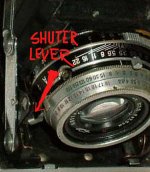Yes Andrew you are certainly right. An assesment of the issues to be cautious about with the Iskras is due.
Upon my experience with four of them, for some silly reason of my own I hapened not to check either focus or rangefinder accuracy, as they all looked ok. And they happened to be ok, but I cannot say that upon checking and correcting a bit, another bit of accuracy may have not been gained.
In very general terms, the main issue is perhaps the status of the materials. Here there are serious differences between one model and other, and Andrew example about how crudely or refinedly the holes are drilled is significative. The variations are extreme. So an auction without clearly visible images of the cosmetics of the camera from all sides is an auction I would ignore without regret.
In the case of the Iskras you are looking for the less used one, within availability common sense limits, and you should ignore without doubt cameras which show a lot of wear. The areas in danger with a very used samples, whose repair is impossible and you will have to replace with a second camera, are the leaf shutter mechanism, the x synch lever, and the springs of the pressure plate, which are not screwed but fixed through pressure buttons.
On one of the four I have an issue I think another friend has been having recently and posted a thread: sometimes the external aluminium shutter lever at the lens compound (
see attached pic), doensn't act in harmony with the hard black levers comunicating the firing push of your finger to the leaf shutter around the lens, via that aluminium lever. Here you have to twist either the black side lever with a lot of force (and this is dangerous) or softly twist the aluminium lever to match the black one, but only after studying beforehand how much and in which direction you should do it. The aluminium lever is delicate, so you will not have many opportunities untill it breaks. But some you will have.
In other sample of my quartet, the shutter mecanism around the lens sounded higly dry and crispy. So I added a small drop of oil and I think I saved the camera.
Finally the endemic problem of the Iskras, at the time I was in business, was the hard to move distance focusing ring, which together with a spartan little handle to push that ring by thumb friction, make the whole thing highly unpleasant. There is a solution to this problem. In fact there are two.
The enligthened fixer solution is to disassemble the basic parts of the lens compound, clean and relube.
But here is the trap. Not any grease or oil will give you the right smoothness and you have to be knowledgeable beforehand of the trademark to use. I never achieved this level so I went for another kitchinette solution:
After cleaning and relubing with what I have, I reasemble the whole thing, but I soften a tiny bit the screws fixing the lens compound to the bellows panel. These four screws are accesible only from the film gate. And also I do the same with one of the two rings holding the lens compound to the bellows panel, also accesible only from the film gate. It is not that you leave it free. You just don't close the torque like an inquisitor. I repeat, this is my kitchinette solution, because I think one of my Iskras was purchased from master Oleg, with everything tigthened as it should be, and the distance ring was still higly soft.
Now I will tell you why a supersilent rangefinder 645 Iskra is not good for me and I went instead for high decibile party noise 645 SLR (Kiev6c/60), against all my silent monastery monk beliefs. With a 645 Iskra, or a Bronica RF, or a Kiev 645 the image you have is portrait oriented. Therefore in order to have a landscape oriented image you will have to twist the camera. Most of the images most of us do are landscape oriented, so most of the times you will use your silent and comparatively light Iskra in a twisted position. And here comes for me a problem that has sent me to pay a lot of money for alternative gear: the Iskra in vertical position is highly difficult to manipulate its focus ring, no matter how soft it may be.
Ok, that's enough for a single post. I remind that good and reliable red hole Iskras are around, you just have to check carefully what are you buying. And as Andrew rightly said, the quality of the red hole border is a good indicator of what you may find inside.
On the other hand, one day I decided to go for an expensive Soviet Camera Store (Ukraine) Iskra with a working semi auto winding mechanism and no holed back, and guess what ? The mechanism proved randomly unreliable, and it was only due to having other Iskras around that I could terminate the auto and assemble a spare red hole back. Imagine what would happen had I not that spare red hole back.
Yet Keith owns a non holed Iskra with a soft distance ring, and
C'est la vie, go protest to the sky. I ceirtainly didn't protested to Trofimov.
Cheers,
Ruben
PS
There is a small Iskra group at flickr:
http://www.flickr.com/groups/58258241@N00/
where there is the following 10MB image you can screen enlarge up to 1x1meter:
http://www.flickr.com/photos/johnnycaldwell/3253265740/sizes/l/in/pool-58258241@N00/

